
528 Chama, N.E., Albuquerque, NM 87108 http://www.cbass.com |

Mr. America Past 40, Short Class
Clarence Bass by Russ Warner
+
|
|
|
Fitness Success Stories (21)
We've heard many success stories over the years, and
here are some of them that are
especially noteworthy and inspiring.
We Have Much in Common
I'm writing to thank you for many years of inspiration.
I'm now 76. I started working out with weights when I was about 10 after being badly beaten by some bullies several years older. I decided "that isn't going to happen again" and got weights for my birthday and started studying martial arts on my own. I'm 5'5" (was 5'6") and at the moment about 148 Lbs.
Over the years this has been a big part of my life except for a couple of very short periods. At this point in my life I feel it is "my medicine." I have had shingles since about 30, but don't get the typical huge rashes but have suffered with neuropathy badly, moving from one part of my body to another as long as I can remember. If I quit working out (I do some aerobics and right now 3 days a week of resistance) I go downhill very fast and end up in a lot of discomfort. I also do a LOT of stretching during work outs, high-reps low-weight, and some isometrics.
I designed my own workouts, even had a fairly popular website but it got to be a pain maintaining it and keeping trouble makers off the message board. Frank Zane and Don Lemmon were occasional visitors.
There are still remnants of my site on archive org here https://web.archive.org/web/20040722082356/http://vortxweb.net/getfit/
I discovered you many years ago and thought your direction was the one I liked. I didn't want to be huge, use chemicals etc. I had always said that I wanted to bridge the gap between runners and on the other end of the spectrum bodybuilders. I felt that runners lacked strength and bodybuilders lacked aerobic capacity.
I also thought flexibility was important. I can still easily touch my palms to the floor bending over with knees straight. Right now my bodyfat is around 7-8%, nowhere near where you have been but I recently upped my workout a bit and it was a little higher; so I'm still gaining slowly.
Partly thanks to you I am still pretty healthy at my age. I avoid medications and can do most anything I could do in my teens.
Every time I go to a Doctor they rave over my condition, as do people when I am at the beach.
I attribute this to my dedication to exercise, which you have reinforced. Never took steroids, creatine, HGH or anything chemical-like to enhance my work. My exercise has never been my mode of income and I never had any desire to get into any related to "business." It's what I consider maintenance.
I'm attaching photos on the Soloflex when I was about 50 and a recent photo at 76.
I want to be the best "me" I can be.
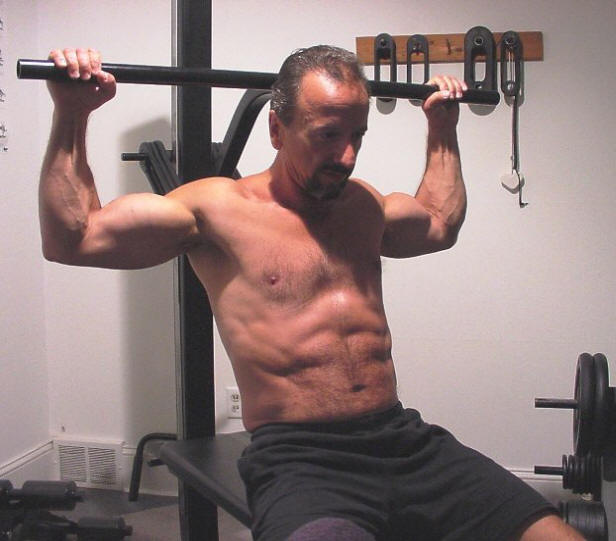
Glad to see you are still pushing yourself, which in itself I think helps us emotionally. I rarely wake up thinking "oh goody I am going to work out today" but I push myself through it and then feel good about disciplining myself. I recall someone on my site commenting "well it's easy for you" but I cleared that up in a hurry, it's not "easy" for me.
So take care and keep going as long as you can.
Sincerely,
Eric Jarrett
* * *
Thanks for sharing your quest with our visitors. Sure wish I had your biceps.
New Year's Resolutions
Clarence,
Have to agree with you regarding New Year's resolutions. Often a waste of time.
First and foremost is to have written goals. I have both daily, and yearly goals.
Secondly, is knowing how the human mind works.
The subconscious does not like change, so you have to start out slowly. Like you said, start walking around the block 3 times a week and slowly work your way into more robust exercise (both weight training and cardio of course). That way you won't upset your subconscious.
Also, knowing all that is needed to create a habit (good or bad) is repetition.
The big challenge I have right now is improvement of my diet. Being well into my sixties I know how critical it is. In younger years all it took was a little more exercise to keep off the pounds. Now that I am in my sixties I realize it takes both to stay at a reasonable weight. Having recently gone to my 50th high school reunion I was appalled to see how much weight my fellow classmates had put on.
One of them informed me that I must possess an above average level of self discipline because I had not put on more weight. I assured him that was not the case. I had simply reprogrammed my mind through repetition to engage in vigorous exercise and better diet (a little bit at a time).
Anyway, great article.
Tim J.
Using a Safety Squat Bar
Hi Clarence
Happy New Year.
I’ve always struggled with squats. Over the years I’ve gotten much more
flexible and able to do a decent squat, just below parallel.
But once
the weight gets above 225, I start to feel it in my lower back and knees
and can’t seem to make progress.
I recently switched to using a safety squat bar. I can’t tell you just
how great this device is.
I squat outside my power rack, and hold on gently to the power rack for
balance and to help me get back up, if I get stuck.
Due to its design, a person squats in a more upright position, taking a
lot of strain off the lower back. Also, a person doesn't actually need
to hold the handles at all. The bar just sits on your shoulders, very
comfortably. You can then have your hands completely free, to help get
up from the bottom position, or as I do, to hold the power rack.
For older lifters, with shoulder issues it is also a godsend.
Anyway, just thought I’d share this with you and your readers.
All the best
David Tempest
Double Trouble: Recovering From Two Surgeries Just One Month Apart
By Dan Keating
When I turned 62 in mid-October of last year, I had never missed more than one week of training since I began working out at age 15.

I have been fortunate with my health throughout my life, never having had to deal with a surgery or major medical issue. Little did I know that the 62nd birthday that I was soon going to be facing not just one, but two significant surgeries in the space of one month.
Heading into my 62nd birthday, I was already aware of a long-planned stomach surgery to treat a chronic cough that stemmed from my acid reflux. That procedure was scheduled for early December. However, about a month before that surgery, I went to an orthopedic surgeon to have him look at my left shoulder, which had been nagging me for several months and was now even affecting my sleep. My shoulder problems were not due to a particular injury, but rather to decades of heavy bench pressing with my slight ectomorph frame that probably was not designed for heaving lifting.
I vividly remember getting the call from the orthopedic physician’s assistant, who told me that my left rotator cuff was more than 90 percent torn and that I should schedule a repair surgery as soon as possible. At this point, I called my stomach surgeon’s office to find out how soon following the stomach surgery that it would be safe to do the shoulder surgery, and they told me a minimum of one month. So, with the stomach surgery set for early December, I scheduled my shoulder surgery for early January.
Bouncing Back from LINX Surgery
Even before the news about needing shoulder surgery, I was already concerned about how my stomach surgery might affect my training. My stomach surgery was a modern approach to treating acid reflux called LINX surgery. The LINX device is a small magnetic bracelet made of titanium that the surgeon wraps around the bottom of the esophagus through four small incisions in the stomach. The surgeon is assisted by remote controlled robot arms that do the actual installation, and the robot is aided by the fact that the patient is inflated with CO2 gas to make everything more accessible for the robot arms.
I was concerned before this first surgery about how my stomach would feel after four cuts through both skin and muscle. However, I was pleasantly surprised when the morning after the surgery (which was outpatient) I was able to push my baby grandson Daniel in his stroller up and down the hills of his neighborhood. A week following the surgery, I was already doing crunches with no ill effects during my only slightly altered workout. My streak of not missing more than a week of workouts was still intact!
Two weeks following the surgery, I had a setback that was more about my digestive system than my muscles. LINX patients are warned that following the implanting of the LINX device, the esophagus takes a couple of weeks to acclimate to the foreign object and eventually develops scar tissue that helps to keep the LINX device in place. In my case, the formation of this scar tissue led to several frustrating days in which I was not able to pass food through the esophagus to my stomach. Unable to keep food down, I lost six pounds in less than a week. I feared that I might have to postpone my shoulder surgery due to weakness and low bodyweight. Fortunately, my stomach surgeon prescribed for me a round of the anti-inflammatory drug prednisone that loosened things up enough for me that I was able to eat normally again and quickly regain the weight that I had lost.
The Streak Finally Ends (sort of)
I had done enough research about rotator cuff surgery to know that I was going to be out of commission for a while after this one. The stomach surgery was just a warmup for the much more debilitating shoulder surgery. Recovery from a shoulder surgery like mine means six weeks in a sling, six more weeks of passive stretching for range of motion, and then only at the three-month mark can you slowly begin regaining strength. However, even with the shoulder surgery, I found ways to make the best of the situation. I was determined to do what I could to prevent losing all my strength and aerobic fitness despite the surgery. Yet I was also determined not to rush things along to the point where I would somehow damage the surgeon’s repair job. I have a friend who tried to do too much immediately following his knee surgery, which simply led to him having a second knee surgery. The last thing I wanted was a second shoulder surgery.
My first rule of recovery following the shoulder surgery was to focus on what I could do (safely) rather than what I could not do. Using this principle as my guide, I was very pleasantly surprised with all the parts of my workout that I could still do even while wearing the shoulder-immobilizing sling that I had to wear for six weeks following the surgery. One week following the surgery, I could do leg and stomach exercises with no problems, and I could even do upper-body exercises if I just used my right arm. I had read somewhere in my research that doing one-limbed exercises would somehow decrease the atrophy on the passive side of the body.
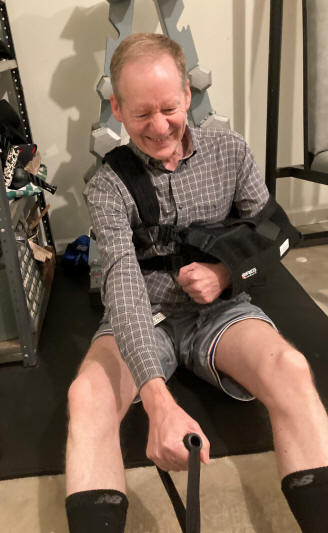
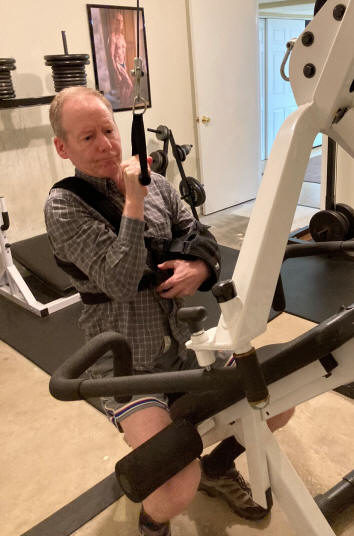
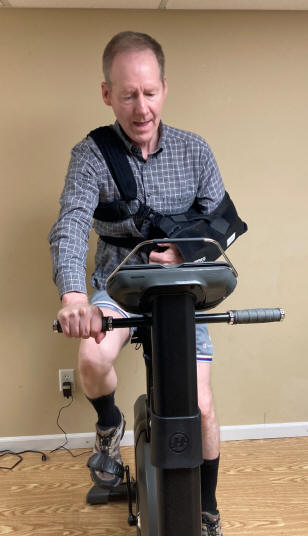
I could also do most of my stretching, core and balance exercises while wearing the sling. Aerobic exercise was easy to do if I stuck to my stationary bike rather than running on my treadmill. At this point, I could not put on a t-shirt to work out, so I just worked out in my shorts and my long sleeve button-up shirt that I would put on each day with the help of my wife Jane. Jane was the key to my recovery from the shoulder surgery with her round-the-clock in-home nursing care, despite her lack of a medical background. She would help me to dress and undress each day, and she would set me up with the high-tech ice-water sleeve in the weeks immediately following the surgery that helped to reduce inflammation.
The second trick I used to avoid atrophy of my left side was to do daily isometric exercises that my outstanding physical therapist, Jake Bauman, showed me. On my first visit to Jake a week after surgery, he gave me a squeeze ball that I could use with my left arm to work the forearm muscles daily. I would also make sure while squeezing the ball each day to do isometric flexes of both my left biceps and left triceps muscles in a way that did not engage the recovering shoulder. In this way, I believe that the atrophy in my left arm was a lot less than it otherwise might have been.
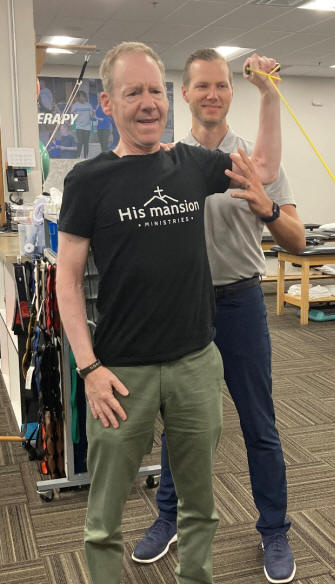
Getting Back to Normal
Once I got my sling off at the six-week mark, I began seeing my PT Jake twice each week to work on regaining the full range of motion for my left shoulder. That involved a lot of passive stretching with Jake at the PT facility and even more time spent at home doing my stretching “homework.” At the three-month mark, I was finally cleared to begin light strengthening work with the left shoulder, and I let Jake be my guide as to what I could safely do so that I would not overdo things. As with the range of motion exercises, this consisted of a combination of what I did in person with Jake plus what I did at home with his assigned exercises.
At the five-month mark, I was cleared to start doing some regular strength training exercises in my home gym with my left arm. At that point, I could not do normal two-handed upper-body exercises because my left side still was not nearly as strong as my right. For about a month, I would separately use each arm for every upper-body movement until I felt that my left side was close enough in strength to the right that I could safely and effectively do two-arm upper-body movements.
Finally, at the six-month mark, I began doing what I felt was a “normal” weight workout, although at this point, I was still using slightly lighter weights than I was before the surgery. The good news was that I was able to start reintroducing certain movements that I had been forced to abandon prior to the surgery because of the pain that those movements had caused for my left shoulder. Jake also showed me some new techniques for doing familiar exercises that would take pressure off the rotator cuff but would still work the targeted muscle group.
Lessons Learned
As I write this essay, I have officially
reached the seven-month mark since my shoulder surgery, and I am now
back to using the weights I was using before the surgery (and in some
cases slightly more!). Just as importantly, I can now lift my grandson
Daniel well over my head and toss him around again like he loves! My
biggest lesson learned is the one that I mentioned earlier, which is
that no matter what your physical limitations, there is always something
that you can still do for your fitness. If you focus on that positive
reality rather than on what you cannot do, you will get a lot more done,
and you will feel much better about your situation.
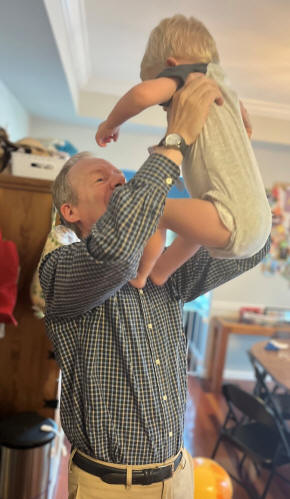
A second lesson I learned from this experience is patience. When I first told Clarence with great trepidation about my upcoming shoulder surgery, he reminded me that before I knew it, I would be back in the gym better than ever. With two hip surgeries in his background, Clarence spoke from experience. And, of course, he was right. Looking back, it all seemed to go by so quickly, and now I can work out and sleep without any pain in my left shoulder.
The third lesson that I learned is that muscle memory is real. You may have heard or read about the physiological phenomenon that someone who has a history of training will recovery more quickly following even a prolonged layoff. I certainly found that to be true in my case. Once I started using challenging weights for my left side at the five-month mark, I was amazed at how quickly my atrophied muscles regenerated. Today when I look in the mirror, I cannot even tell the difference between my right and my left sides.
Going back to my first lesson above, I have become increasingly aware that as we age, we often must give up certain things or activities. However, even as we are sometimes forced to let go of familiar routines or practices, there is almost always a way to replace them with something else. If we keep a positive mindset of focusing on what we can do rather than on what we can no longer do, then we can be confident that we will keep training well into our golden years!
Dan Keating
September 1, 2024
Comment on this article: FEEDBACK
Ripped Enterprises, P.O. Box 51236, Albuquerque, New Mexico 87181-1236
or
street address: 528 Chama, N.E., Albuquerque, New Mexico 87108,
Phone (505)
266-5858 , e-mail: cncbass@aol.com ,
Office hours: Monday-Friday, 8-5, Mountain time
Home | Products Index | Ripped Bks | Lean Adv. Bks | Lean For Life | Recommended Bks | |Consultations | Tapes | To Order | Feedback]
Copyright © 2024 Clarence and Carol Bass. All rights reserved.